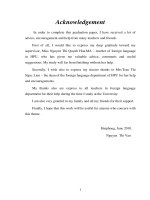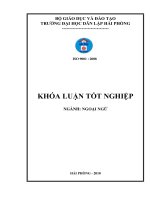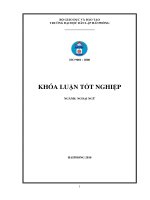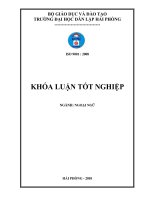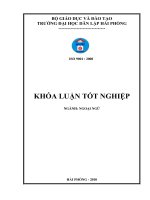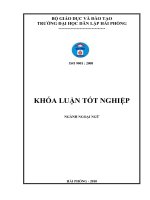Study on determination of heat pump drying mode for manufacturing red pepper
Bạn đang xem bản rút gọn của tài liệu. Xem và tải ngay bản đầy đủ của tài liệu tại đây (200.25 KB, 6 trang )
Vietnam Academy of Agricultural Sciences (VAAS)
STUDY ON DETERMINATION OF HEAT PUMP DRYING MODE
FOR MANUFACTURING RED PEPPER
Pham Van ao*1, Phan anh Binh1, Vo i uy Dung1,
Truong Minh Hang 1, Tran i am Ha1, Nguyen i Kim Oanh1
Abstract
Red pepper is one of the special products made from ripe and high quality pepper fruits. Because of its high quality,
red pepper is o en sold at much higher price than that of black pepper, which brings farmers high incomes. However,
at present, processing technology of red pepper in Vietnam is not completed yet. Red pepper has been mainly
produced by using natural drying method. As the result, the quality of products is low, the color of peppercorns is
not satisfactory and its taste is not really di erent compared with other pepper products. e method of heat pump
drying being widely used in the processing of agricultural products and foodstu s to keep color and quality of the
products (especially for products are easily destroyed by heat like vitamins). Research on red pepper production
by applying the method of heat pump drying has been conducted by WASI since 2017. e best heat pump drying
regime was dertermined as: Temperature at 350C, relative humidity at 40%, wind speed at 3 mps, drying time in 36
hours. e red pepper retained natural color of ripe beans. e avour and the quality of dried red pepper products
were better than that of control samples. Besides, the treatment of raw material was processed by hot water at 900C
in 1 minute before drying is able to improve quality of red pepper products.
Keywords: Pepper processing, red pepper, heat pump drying, drying mode
INTRODUCTION
Nowadays, peppercorn is one of Vietnam‘s key export
commodities with output of 215,000 tonnes, and
export turnover of $ 1.12 billion (Ministry of Industry
and Trade, 2018). However, the 95% of exported
pepper products is black pepper. e export price
of black pepper is usually lower than other pepper
products from 30% to 40% of value (ITPC, 2017).
In Vietnam, red pepper products were only produced
in two districts: Chu Se (Gia Lai) and Phu Quoc
(Kien Giang). e production volume is not high, but
the price of red pepper are 3 - 4 times higher than
black pepper. Production technology of red pepper is
quite simple, such as manual drying or heat drying.
New technologies and equipment are not applied yet,
such as enzyme deactivation, freeze drying and high
frequency waves technology so that the quality and
color of the products are not stable.
e advantage of heat pump drying method is that the
drying process can be carried out at low temperature
and low humidity, resulting in little impact on
biochemical changes of product by heat. In addition,
the circulatory drying system is able to keep the
smell, taste and nutritional ingredients; limit the loss
of taste of the material and help to increase the value
of the product a er drying. erefore, the method of
drying heat pump is very cared and applied to many
products such as dried fruits, vegetables, seafood,
and spices (HCMC Department of Science and
Technology, 2016). Research on using the heat pump
1
*
drying method for red pepper is a feasible way in
order to increase the value of red pepper, and stabilize
the quality and color of products.
Objectives: Determination of temperature and
drying time for producing red pepper by heat pump
drying method and determination of the method for
processing raw materials before drying red pepper
MATERIALS AND METHODS
Materials
- Materials: Fresh green pepper berries were harvested
in Dak Lak province, Vietnam, then were separated
by specialized equipment, cleaned and graded by
screening equipment to select grain size d ≥ 5mm
before testing.
- Equipment: Heat pump drying system was
manufactured in 2017 in Vietnam.
e system
includes 20 drying racks and a set of controllers of
drying temperature, humidity and time. Its capacity
is 200 kg per batch.
e design and manufacture
of Heat pump drying system had been the result of
researching cooperation between WASI and Tran
Lam company.
Methods
Experiment 1: Determination of suitable drying
temperature for red pepper
e experiment was used completely randomized
design (CRD) with 1 factor and 4 treatments. Each
e Western Highlands Agriculture and Forestry Science Institute (WASI)
Correspondong author: Pham Van ao. Email:
58
Journal of Vietnam Agricultural Science and Technology - No.1(3)/2018
treatment used 30 kg of pepper material with 3
replications. Each treatment was dried at di erent
temperatures, but used the same input air humidity
of 40% and wind speed at 3 m/s. e variation in
temperature and humidity is less than ± 20C and
3%, respectively. e experiment was organized as
follows: Treatment 1 (T1): drying at 250C; treatment 2
(T2): drying at 300C; treatment 3 (T3): drying at 350C;
treatment 4 (T4): drying at 400C.
Determination of the quality of raw materials
e quality of pepper raw materials impacts directly
on the quality of products a er drying. Materials used
to produce red pepper usually include peppercorn
with di erent color. is has signi cant in uence on
the quality of nal products. Color changes during
drying process would lead to negative e ects on the
quality of the nal products.
Table 1. Input quality of raw materials
Experiment 2: Determination of method for
processing raw materials before drying for improving
the product quality
e experiment was used completely randomized
design (CRD) with 1 factor and 4 treatments. Each
treatment used 30 kg of pepper material with 3
replications. is experiment was carried out based
on the optimum condition in experiment 1.
e
experiment was organized as follows: CT1: Using hot
water 900C in 1 minute; CT2: Using high frequency
waves 2450 Mhz, 2000 w in 30 s; CT3: Using water in
2 minutes; CT4: Control (untreated).
Indicators
- Quality of raw materials: determining the color
bean by sensory.
- Moisture: was determined by the method of drying
to constant weight.
- Color and taste of the product: were evaluated by
sensory.
- Peperine content (%): was determined according to
TCVN 9683:2013.
- Volatile oils content (ml/100g): was determined
according to TCVN 7039:2013.
Time and place of the study
e experiments were carried out in 2017 – 2018
at the Western Highlands Agriculture and Forestry
Science Institute (WASI).
RESULTS AND DISCUSSION
Determination of suitable drying temperature for
red pepper
Fresh peppercrons were dried at di erent
temperatures, air humidity of 40% and wind speed
at 3 mps. Air humidity in the drying chamber varied
according to the dry level of the peppercorn.
e
quality criteria of raw materials, moisture reduction
rate of peppercorn, the quality of products were
determined to evaluate e ects of heat pump drying
method on red pepper.
Quality of raw materials a er drying
(% grain color)
Dark red
Light red
Yellow
Green
Black
19.6
37.8
32.3
7.1
3.2
e table 1 shows the quality of raw materials
used for producing red pepper. As seen from the
table, although raw materials were selected before
processing, there were still presence of many
peppercorns with di erent colors. In general, dark
red, red and yellow are good colors for processing
red pepper. However, some green and black beans
a ect adversely on the quality of the nal products.
e results showed that the quality of raw materials
in the experiment was quite good with 19.6% dark
red beans, 37.8% light red bean and 32.3% yellow
beans. Besides, there were a small rate of green beans
(7.1%) and black beans (3.2%).
E ect of drying regimes on the moisture reduction of
peppercorn
According to TCVN 7036:2008, the moisture content
for black pepper preservation is 12 - 13% wb. us,
dry red pepper products should be dried as required.
Changes of the grain moisture could cause changes of
pepper colors during drying.
e results (Figure 1) showed that the grain moisture
reduction between the treatments was di erent. e
drying temperature was higher, the drying speed was
faster and the drying time was shorter. For Treatment 1
(drying at 250C), it took 48 hours to dry raw material
to reach moisture as required (12 - 13%); 40 hours for
treatment 2 (drying at 300C); 36 hours for treatment 3
(drying at 350C); and 32 hours for treatment 4 (drying
at 400C). e longer the drying time was, the more
in uent the quality of product would be. e higher
temperature was, the more e ective the product
quality would be.
59
Vietnam Academy of Agricultural Sciences (VAAS)
7
7
7
7
Figure 1. Grain moisture during drying (%wb)
E ect of drying regimes on the quality of
products
nal
During the drying process, the color of the pepper
would be changed according to drying temperatures
and drying times (Table 2).
Red pepper in the treatments was dried at di erent
temperatures, the drying time of the products was
di erent. As the result, the products would be
di erent in grain color ratio (Table 3).
Table 2. Changes of the grain colors during drying
Grain colors
before drying
Dark red
Light red
Yellow
Green
Black
Grain colors a er drying
Dark red, black
Dark red, light red, black
Dark red, light red, yellow, black
Green, black
Black
Table 3. Quality of pepper products a er drying
Treatment
Dark
red
Grain color (%)
Light
Yellow
Green
red
T1
19.2
32.3 a
15.1
T2
21.6
32.1 a
T3
23.9
T4
Natural
drying
Black
Piperine
(%)
Volatile oils
(ml/100g)
5.5
27.9 c
4.74a
2.23a
14.5
4.6
27.2 c
4.76a
2.19a
33.2 a
12.2
3.3
27.4 c
4.79a
2.26a
26.3
27.3 b
11.4
2.8
32.2 b
4.75a
2.18a
28.3
8.5 c
0
0
63.2 a
4.73a
2.06a
Notes: a, b, c on the same column indicate di erence signi cantly at 95%.
60
Flavor of product
Spicy avor,
characteristic aroma
Spicy avor,
characteristic aroma
Spicy avor,
characteristic aroma
Spicy avor,
characteristic aroma
Spicy avor,
characteristic aroma
Journal of Vietnam Agricultural Science and Technology - No.1(3)/2018
As in the table 3, the color of nal product in each
treatment was signi cantly di erent in comparison
to the control (natural drying). For treatments using
heat-pump drying, the percentage of grains that were
changed in color during drying was lower than that
for control sample, especially for red and yellow
beans. e percentage of the black beans in treatments
(27.2 - 32.2%) was statiscically signi cant lower than
that of the control samples (63.2%). e heat pump
drying system proves to be able to keep the light red
color of pepper quite well, between 27.3% and 33.2%,
among them, the lower temperature gave the higher
ratio of pepper with light red color. However, the
high temperature from 350C to 400C contributed to
reduce signi cantly the ratio of these pepper. us, it
should be set the drying temperature under 350C in
order to gain products with high ratio of red beans
and low ratio of black beans. e result of evaluation
of peperine content (4.74 - 4.8%) and volatile oil
content (2.18 - 2.26 ml/100g of dry matter) showed
that there was not any di erence between the drying
treatments; and there was not much di erences
comparing with the control samples. ese results
correspond to the results of Krishnapura Srinivasan
(Krishnapura Srinivasan, 2009), KC Saha (KC Saha
et al., 2013) and S. Morshed (S. Morshed et al., 2017).
e product a er drying has the spicy avour which
is special aroma of pepper.
Determination of method for processing raw
materials before drying for improving the quality
of products
Determination of raw material quality
e purpose of processing raw materials before
drying is to inactivate the enzyme inside the beans
in order to reduce the color change of the pepper
happening during drying.
Table 4. Quality of raw materials a er processing
Treatment
Quality of raw materials
a er processing (%)
Dark
red
Light
Yellow Green Black
red
CT1
20.4
37.4
29.5
8.5
4.2
CT2
21.5
34.0
31.8
8.5
4.2
CT3
18.6
36.4
32.3
8.5
4.2
Raw
material
(untreated)
18.6
36.4
32.3
8.5
4.2
e results (Table 4) showed that a er processing,
there was slightly di erent in the color of pepper
between these treatments and raw material.
Treatment 3, which used , cold water to treat raw
materials, did not a ect the color of pepper. us,
the color of pepper was the same as the color of
raw material. In treatment using hot water, the raw
materials a er processing were changed in color from
yellow to light red and from light red to dark red.
Dark red beans ratio increased about 5% compared to
the raw material (from 18.6% to 20.4%). In treatment
processing raw material with microwave, there was
a quick change in color, especially from light red to
dark red. Dark red beans ratio increased about 8 %
compared to the raw material (from 18.6% to 21.5%).
E ect of drying regimes on the moisture reduction of
peppercorn
e results showed that when the raw materials
processed by cold water and hot water, the moisture
content of the material increased (Figure 2). However
in the treatment processed by hot water, the moisture
of the material reduced quickly a er 4 hours and had
equal amount to the control; while in the treatment
processed by microwave, the moisture content of
the raw materials reduced quickly from the begin of
drying step and was always at the lowest level during
drying compared to other treatments. In contrast,
the moisture content of peper in the treatment
processed with cold water increased quickly from the
begining of drying and was always at the highest level
compared to other treatments during drying.
e
treatment processed by microwave gave product with
the required moisture (12 - 13%) a er 32 hours of
drying. It took 36 hours for treatments processed by
hot water and control to gain desired moisture while
the treatment using cold water was not able to achieve
required moisture a er 36 hours of drying.
E ect of drying regimes on the the quality of nal
products
e results showed that the color of the grain beans
between the treatments was signi cant di erence
(Table 5). e treatments processed by hot water and
microwave made the color of grains very nice (the
light red beans were higher) and reduced the ratio
of the black beans. Probably because it was able to
inactivate enzyme when processing by hot water and
microwave contributing to the maintainance of the
color of product better and not making the color of
raw materials to be changed too much during drying.
e grain color of the treatment processed with cold
water were not signi cantly di erent compared to the
61
Vietnam Academy of Agricultural Sciences (VAAS)
control. In order to use microwave for treating raw
material in large quantities, it is necessary to invest
high-value equipment with high safety level for
7
workers. erefore, it is recommended that hot water
should be used in processing raw material before
drying in order to decrease investment cost.
7
7
7
Figure 2. Grain moisture during drying (%wb)
e results of the evaluation of pepper content,
volatile oil content and product quality showed that
there was not di erence between the treatments.
e content of peperine (4.76 - 4.81%), volatile oil
content (2.14 - 2.20 ml/100 g dry matter) correspond
to the results of Krishnapura Srinivasan (Krishnapura
Srinivasan, 2009), KC Saha (KC Saha et al., 2013) and
S. Morshed (S. Morshed et al., 2017). e product of
all treatments had a spicy avor which has special
aroma of pepper.
e treatment processed by hot
water produced cleaner product compared to other
treatments.
Table 5. Quality of pepper product a er drying
Grain color (%)
Dark red
Light red
Yellow
Green
Black
Piperine
(%)
Volatile oils
(ml/100g)
Flavor of
product
CT1
17.4
39.8a
13.2
2.3
27.3ab
4.80a
2.19a
Spicy avor, clean
and characteristic
aroma
CT2
16.6
35.5ab
18.5
4.2
25.2 b
4.76a
2.14a
Spicy avor,
characteristic
aroma
CT3
18.3
31.8b
14.2
4.3
31.4a
4.81a
2.20a
Spicy avor,
characteristic
aroma
CT4
18.7
32.5b
14.6
4.6
29.6ab
4.78a
2.16a
Spicy avor,
characteristic
aroma
Treatment
Notes: a, b, c on the same column indicate di erence signi cantly at 95%.
62
Journal of Vietnam Agricultural Science and Technology - No.1(3)/2018
(a)
(b)
(c)
Figure 3. Pepper before (a), during (b) and a er drying (c) by heat pump drying
CONCLUSIONS
e heat pump drying regime suitable for red pepper
production was: drying temperature at 350C, relative
humidity 40%, wind speed of 3 mps and drying
time in 36 hours. the moisture content of products
were less than 12.5%, black pepper ratio was 27.5%,
color and sensory quality of products were very
good. Besides, the treatment of raw materials with
hot water at 900C in 1 minute was able to increase
product quality and keep the color of product better
and shorten drying time.
REFERENCES
Center for Science and Technology Information
and Statistics, 2016. Trend analysis report and
technology. HCMC Department of Science and
Technology.
Krishnapura Srinivasan, 2009. Black Pepper (Piper
nigrum) and Its Bioactive Compound, Piperine.
Researchgate, May, 2009.
Ministry of Industry and Trade, 2018. Vietnam
Export-Import Report 2017. Publishing House of
Industry and Trade, Hanoi 2018.
Minitry of Science and Technology, 2008. TCVN
7036:2008. Black pepper (Piper nigrum L.) Speci cation.
Minitry of Science and Technology, 2013. TCVN 70392013. Spices, condiments and herbs - Determination
of volatile oil content (hydrodistillation method).
Minitry of Science and Technology, 2013. TCVN
9683:2013. Black pepper and white pepper, whole
or ground - Determination of piperine content Spectrophotometric method.
Morshed S., M.D. Hossain, M. Ahmad, M. Junayed,
2017. Physicochemical Characteristics of Essential
Oil of Black Pepper (Piper nigrum) Cultivated in
Chittagong, Bangladesh. Journal of Food Quality and
Hazards Control, 4 (2017): 66-69.
Saha K. C., H. P. Seal and M. A. Noor, 2013. Isolation
and characterization of piperine from the fruits of
black pepper (Piper nigrum). J. Bangladesh Agril.
Univ., 11(1): 11-16, 2013.
Trade Promotion and Investment Center of Ho Chi
Minh City (ITPC), 2017. Spices - pepper, 2017.
Date received: 22/9/2018
Date reviewed: 16/10/2018
Reviewer: Assoc. Prof. Dr. Tran Nguyen Phuong Lan
Date approved for publication: 25/10/2018
INFLUENCE OF ABIOTIC FACTORS ON MESOFAUNA IN GUAVA
(Psidium Guajava) ECOSYSTEM IN BENGALURU, KARNATAKA, INDIA
Nguyen
i Kim
oa*1 and N. G. Kumar 2
Abstract
Abiotic factors viz., atmospheric temperature, relative humidity, sunshine hours, rainfall, soil temperature and moisture
play a crucial role in the development and sustainability of the soil mesofaunal population. An experiment was carried
out in Guava (Psidium guajava L.) ecosystem from October, 2015 to September, 2016. Soil and litter samples were
drawn and mesofauna were extracted at fortnightly interval. e results indicated that contribution of abiotic factors
on the abundance of Collembola, cryptostigmatids, other Acari, mesostigmatids and other invertebrates of guava
Southern Horticultural Research Institute (SOFRI), Vietnam
University of Agricultural Sciences, GKVK, Bengaluru-65, India
*
Corresponding author: Nguyen i Kim oa. Email:
1
2
63

